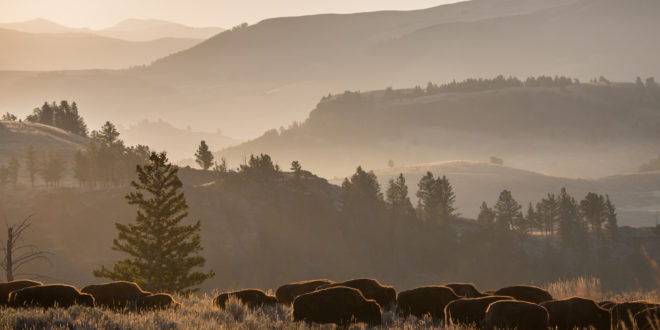There are roughly 4,800 bison in the Yellowstone National Park herd, according to a survey conducted by park biologists this August.
That number is way down from the estimated 5,500 bison that comprised the herd last year. Indeed, this winter, over 1,200 bison were hunted and slaughtered as part of operations under the Interagency Bison Management Plan, the largest number of bison killed over one season in recent memory.
It is worth noting, however, that the current herd count is well above the IBMP’s preferred threshold of 3,000 bison—a count that has never been met since operations began in 2000.
According to the Bozeman Daily Chronicle, the informal count is part of the park’s annual report, which is normally released earlier in the year. This year, counts ran late. Park spokesman Jonathan Shafer told the Chronicle that the full population report will be released in a few days. From the Chronicle:
The number the park counted this year became public when Montana’s state veterinarian Marty Zaluski offered it to the Montana Environmental Quality Council, a panel of legislators and citizens that met in Helena on Thursday.
“They are down from last year,” Zaluski said.
State, federal and tribal government agencies are involved in the management of bison. They are working now to line out how they will try to reduce the population this winter, which will again likely include both hunting and slaughter.
Hunters licensed through five tribal governments and the state of Montana took a total of 468 bison last year. Another 748 were slaughtered and distributed to Native American tribes through the Intertribal Buffalo Council.
A controversial practice, the annual bison hunt/slaughter has received increasing pushback by environmental and conservation groups, who think the measure is unnecessary and damaging to the bison’s long-term survival.
Although bison are permitted to roam year-round in parts of southern and southwestern Montana, they are not allowed beyond those boundaries due to concerns that they could spread brucellosis to local cattle. Brucellosis causes cattle to abort their young; further, further, since brucellosis can be transmitted to people, any cattle herd that tests positive for the disease must be quarantined and potentially liquidated.
There have been no documented cases of brucellosis transmission between bison and cattle.
Discussions over how to update the IBMP have stagnated over the past few years due to disagreements. However, several factors have changed over the past few years, which may help stakeholders out of their current rut.
For instance, over the past few years, the push to introduce quarantining (keeping bison until they can be cleared of brucellosis, which is essentially the only barrier preventing Yellowstone bison from leaving the Greater Yellowstone Area) has gained momentum.
The Fort Peck Indian Reservation in eastern Montana has constructed a facility just for this purpose; the park even promised 40 bison to the tribes. After some political wrangling, however, only 24 bison, all bulls, were saved. Even then, those bison have not been shipped to Fort Peck. Instead, Yellowstone officials are looking at converting part of Stephens Creek into a bison quarantine.
One Montana legislator sought to remove this political barrier by striking the brucellosis prohibition from shipping animals like bison around the state, but his bill was tabled in the Montana House.
Once screened and cleared for brucellosis, quarantined Yellowstone bison would likely be shipped to places like Fort Peck or to other free-roaming herds. As one of the few herds that has never been domesticated, Yellowstone bison’s “pristine” genes are much sought after for new herds.
In addition to quarantine talks, the conversation around brucellosis has shifted away from bison and toward elk, who are seen as a higher risk for brucellosis transmission. Indeed, according to the Chronicle, Montana is looking at stepping up their elk management with regards to brucellosis:
The Environmental Quality Council voted 10-6 on Thursday to ask Montana Fish, Wildlife and Parks to look into what it would take to eliminate the brucellosis risk from elk.
Sen. Mike Phillips, D-Bozeman, proposed the study, which he said would put the focus on the right animal.
“We’ve gone out of our way to come up with ways of managing bison,” he said. “Let’s put the bull’s-eye where it belongs.”
Some Republicans opposed the move, including Kerry White, R-Bozeman. He said he thinks the move will be focused on eliminating livestock so wildlife can go into more places without posing a risk of brucellosis transmission.
“That’s moving in the direction of removing livestock from the landscape,” White said.
 Yellowstone Insider Your Complete Guide to America's First National Park
Yellowstone Insider Your Complete Guide to America's First National Park





